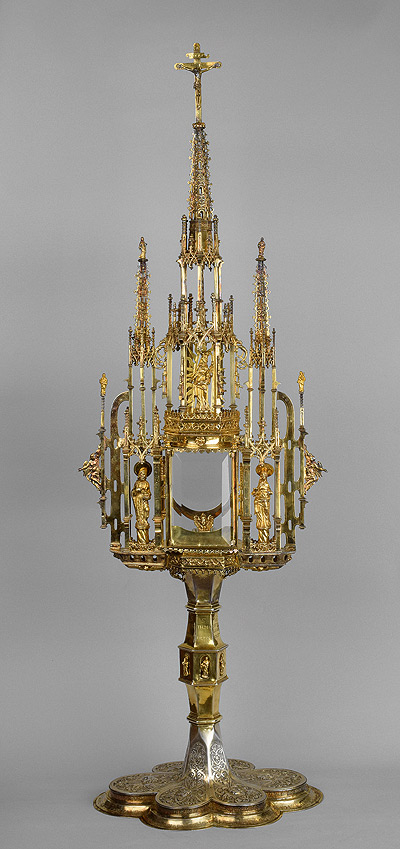Průzkumy památek 2020, 27(1):59-72 | DOI: 10.56112/pp.2020.1.05
Silesian Goldsmithery Relics of the 17th and 18th Centuries
- Národní památkový ústav, územní odborné pracoviště v Kroměříži

Silesia was an inseparable part of the Lands of the Bohemian Crown from the Middle Ages to the signature of the Treaty of Breslau in 1742. Following the War of the Austrian Succession, the Habsburg Monarchy kept only a small part of Silesia which is today situated in the Moravian-Silesian Region and the Olomouc Region. The aim of the following text is to contribute to the issuewith the preserved fragment of the Silesian goldsmiths production of the 17th and 18th centuries especially the Nysa-based goldsmith Martin Voglhund that is today owned by the Roman Catholic Church in the Jeseník Districtand alsoelsewhere in Central Moravia which was discovered during the aerial research of Baroque liturgical objects made of precious metals.
Keywords: liturgical vessels and tools - goldsmithery and silver plating - Baroque - Silesia - Wrocław - Nysa - Lehnice - Opava - Martin Voglhund - applied art - arts and crafts - 17th and 18th centuries
Published: June 15, 2020 Show citation
References
- J. Samsour, Prodej věcí movitých a zvláště klenotů ze zrušených klášterů za Josefa II. na Moravě. Brno 1912.
- K. Täubl, Vývoj českého puncovnictví. Praha 1977.
- F. Honzák - M. Pečenka - J. Vlčková, Evropa v proměnách staletí. Praha 1995.
- J. Olšovský, Barokní sochy na slezském venkově. Mezi místní tvorbou a importy, Zprávy památkové péče 77, č. 1-2, 2017, s. 47.
- E. Hintze - K. Masner, Goldschmiedearbeiten Schlesiens. Breslau 1911.
- P. Noever, Kunst und Industrie. Die Anfänge des Museums für Angewandte Kunst in Wien. Wien: MAK und Hatje Cantz Verlag 2000.
- K. Pechstein - V. Effmert, Schlesische Goldschmiedearbeiten im Germanischen Nationalmuseum. Nürnberk 1990.
- E. Hintze, Alt-Neisser Goldschmiedekunst, Jahres-Bericht des Neisser Kunst- und Altertums-Vereins IX., 1905, s. 13-19.
- E. Hintze, Die Breslauer Goldschmiede. Eine archivalische Studie. Breslau 1906.
- E. W. Braun, Alt-Troppauer Goldschmiedekunst. Sonderabdruck aus der "Zeitschrift für Geschichte und Kultur - Geschichte Österreichisch-Schlesiens", Jahrgang 1905, Heft 1. Troppau 1905.
- E. von Czihak, Die Breslauer Golschmiede. Kunstgewerbeblatt 1907.
- E. Hintze, Schlesische Goldschmiede. Schlesiens Vorzeit in Bild und Schrift: Zeitschrift des Schlesischen Altertumsvereins: Jahrbuch des Schlesischen Museums für Kunstgewerbe und Altertümer VI., Breslau 1912, s. 93-138.
- E. Hintze, Schlesiens Vorzeit in Bild und Schrift: Zeitschrift des Schlesischen Altertumsvereins: Jahrbuch des Schlesischen Museums für Kunstgewerbe und Altertümer VII., 1916 (1919), s. 136-175.
- C. Gündel, Die Goldschmiedekunst in Breslau. Berlin: Steiniger-Verlage 1940.
- A. Semerád, Puncovnictví na Moravě, in: Zlatnictví, sborník pro umělecké řemeslo, Supplementum 1, 1972, s. 63-66.
- B. Samek, Umělecké památky Moravy a Slezska 1 (A-I). Brno: Academia 1994.
- B. Samek, Umělecké památky Moravy a Slezska 2 (J-N). Brno: Academia 1999.
- DS. [D. Stehlíková], Master GR (ER), Monstrance from Jeseník, in: I. Hlobil ed., The last flowers of the middle ages from the gothic to the renaissance in Moravia and Silesia. Olomouc: Muzeum umění 2000, s. 201-202.
- K. Growka, Z letopisů města Jeseníku - Jesenická monstrance, in: Naše město. Informační měsíčník města Jeseník, březen 2017, s. 14.
- A. Drechsler, Altvaterland I. Olmütz 1929.
- O. Jakubec - M. Perůtka edd., Olomoucké baroko. Výtvarná kultura let 1620-1780. 2/Katalog. Olomouc 2010.
- A. Grossová, Biskupská Kroměříž - jedno z center výroby liturgických předmětů z drahých kovů v období baroka na Moravě, Zprávy památkové péče 78, 2018, s. 317 a 329.
 Go to original source...
Go to original source... - J. Hradilová, Ex libris Karla Maxmiliána z Fragsteinu, in: Jesenicko 8, 2007, s. 47-48.
- A. Somers Cocks, Baroque Silver: 1610-1725, in: C. Blair ed., The History of Silver. London 2000.
- M. Rosenberk, Der Golschmiede Merkzeichen 3. Deutschland N-Z. Frankfurt am Main 1925.
- https://de.wikipedia.org/wiki/Karl_Masner [vyhledáno dne 27. ledna 2020].
- https://de.wikipedia.org/wiki/Erwin_Hintze [vyhledáno dne 27. ledna 2020].
- https://cs.wikipedia.org/wiki/Kostel_svat%C3%A9ho_K%C5%99%C3%AD%C5%BEe_(Zlat%C3%A9_Hory) [vyhledáno dne 19. února 2020].
This is an open access article distributed under the terms of the Creative Commons Attribution-NonCommercial-ShareAlike 4.0 International License (CC BY-NC-SA 4.0), which permits non-comercial use, distribution, and reproduction in any medium, provided the original publication is properly cited. No use, distribution or reproduction is permitted which does not comply with these terms.



